Home / Magazine / Material Engineering & Nanotechnology / New luminescent nanomaterials for Photovoltaics

A study on the development of a new high-efficiency, highly stable luminescent material for photovoltaics has been published in «Nano Energy».
This research is the fruit of a collaboration between the Politecnico di Milano (Department of Chemistry, Materials, and Chemical Engineering “Giulio Natta”), the Università degli Studi di Milano, and the Istituto di Scienze e Tecnologie Chimiche “Giulio Natta” (SCITEC) under the National Research Council (CNR).
One of today’s promising technologies for capturing and converting sunlight is called luminescent solar concentrators (LSC), materials containing luminescent colorants (luminophores) which collect incident photons and re-emit them through photoluminescence. The collected and re-emitted light is then converted into electrical energy through the use of small photovoltaic cells. The luminophores’ capacity to also collect diffuse light makes the use of LSCs particularly advantageous in low lighting conditions. They may even be integrated as active semitransparent windows in buildings.
One problem, however, that strongly limits the current performance of LSCs is their strong molecular aggregation. Interactions between luminophores induces the formation of non-luminescent aggregates that lead to a drastic drop in the light re-emitted from the device, thus reducing its efficiency. By nanoencapsulating the high-efficiency luminophores for LSCs, the new luminescent material studied in the laboratories at the Politecnico solves this problem, guaranteeing the luminophores’ full emission properties, even in the aggregate state.